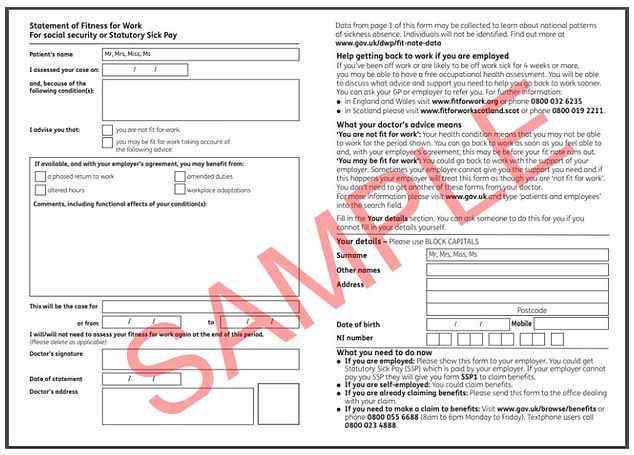England is NOT working: More people than ever are requesting sick leave, with a rise in the number of long-term sick people receiving benefits, official figures show
Data shows that more than 1.1 million people reported sick in the first three months of this year, an increase of almost 40,000 compared to the same period last year.
NHS figures also show that GPs were issuing more long-term sick notes (longer than five weeks), with these letters being particularly prevalent in the North West of England.
The fewest sick notes, also known as ‘fit notes’, per capita were issued in London, the Home Counties and rural Yorkshire.
According to new data released today by the NHS, the number of sick leave claims fell slightly in January, February and March, by 1.2 per cent, compared to last year. The total number of sick leave claims signed by GPs came to 2,934,256.
However, the number of ‘sick notes’, or illnesses for which a sick note was required, increased by 3.5 percent.
The government has made it a priority to get people off benefits and NHS waiting lists and back into work (Stock photo)

NHS data shows GPs signed more long-term sick notes, also known as ‘fit notes’, this year than last year.
This indicates that where previously one disease was covered by multiple sickness notifications, long-term sickness notifications are now being made more often.
Separate figures show that the number of sick leave reports lasting five weeks or longer in the first three months of this year was 1,186,059, compared with 1,151,408 in the same period last year.
Lancashire, Cumbria, Merseyside and Manchester had the highest number of cases reported per 100,000 population.
Blackpool had the highest case rate overall, at 4,323 per 100,000 people in March this year.
North West London had the lowest population, with 1,445 per 100,000.
In 37 percent of cases in which a diagnosis was made, mental and behavioral disorders were cited as the reason for writing a doctor’s note.
The extent of Britain’s doctor’s note culture was highlighted in April when it emerged that the number of doctor’s notes written had doubled in less than a decade.
Last year, doctors in England wrote 11 million sick notes, an increase of 108 percent on the 5.3 million in 2015.
Campaigners have called for an overhaul of the system to tackle long-term sick leave, warning it is stifling the economy and creating an unsustainable welfare system.
A third of people who receive a sick note are declared sick for four weeks or longer, after which 20 percent never return to work.
Further research shows that 80 percent of employees never return if they leave for six months.
Last year, a staggering 186 million working days were lost due to illness or injury, and the number of people who were absent for long periods due to mental health or behavioural problems increased dramatically.
Meanwhile, the Office for Budget Responsibility predicts that spending on disability and invalidity benefits will rise by 49 per cent to £90.9 billion between 2023/24 and 2028/29.
